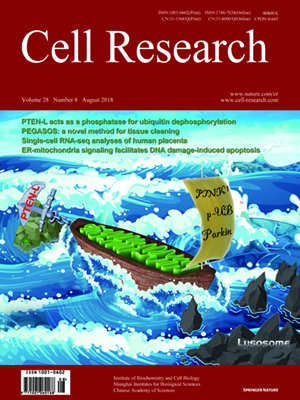
Volume 28, No 8, Aug 2018
ISSN: 1001-0602
EISSN: 1748-7838 2018
impact factor 17.848*
(Clarivate Analytics, 2019)
Volume 28 Issue 8, August 2018: 855-861
ORIGINAL ARTICLES
BE-PLUS: a new base editing tool with broadened editing window and enhanced fidelity
Wen Jiang 1, Songjie Feng 2,3,4, Shisheng Huang 2, Wenxia Yu 2, Guanglei Li 2, Guang Yang 2, Yajing Liu 2,3,4, Yu Zhang 2, Lei Zhang 3,4,Yu Hou 1
, Jia Chen 2, Jieping Chen 1 and Xingxu Huang 2
1Department of Hematology, Southwest Hospital, Third Military Medical University (Army Medical University), 400038 Chongqing, China; 2School of Life Science and Technology,
ShanghaiTech University, 201210 Shanghai, China; 3University of Chinese Academy of Sciences, 100049 Beijing, China and 4Shanghai Institutes for Biological Sciences, Chinese Academy of Sciences, 201210 Shanghai, China
Correspondence: Correspondence: Jieping Chen (chenjpxn@163.com) or Xingxu Huang (huangxx@shanghaitech.edu.cn)These authors contributed equally: Wen Jiang, Songjie Feng
Base editor (BE), containing a cytidine deaminase and catalytically defective Cas9, has been widely used to perform base editing. However, the narrow editing window of BE limits its utility. Here, we developed a new editing technology named as base editor for programming larger C to U (T) scope (BE-PLUS) by fusing 10 copies of GCN4 peptide to nCas9(D10A) for recruiting scFv-APOBEC-UGI-GB1 to the target sites. The new system achieves base editing with a broadened window, resulting in an increased genome-targeting scope. Interestingly, the new system yielded much fewer unwanted indels and non-C-to-T conversions. We also demonstrated its potential use in gene disruption across the whole genome through induction of stop codons (iSTOP). Taken together, the BE-PLUS system offers a new editing tool with increased editing window and enhanced fidelity.
https://doi.org/10.1038/s41422-018-0052-4
FULL TEXT | PDF
Browse 2033


